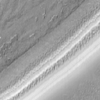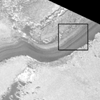









  


|
Weather and Climate: A Brief Look at the Martian Almanac

The weather (day-to-day temperature, winds, pressure, and precipitation)
and climate (long term trends in weather)
of a planet are set by factors like the distance of a planet from the Sun,
its rotation rate, and the properties of its atmosphere. Some of these
factors are surprisingly Earth-like. Mars has a 24-and-a-half hour day
and is tilted on its axis 25 degrees, just 2 degrees more than Earth. Unlike
Earth, however, Mars orbits the Sun is 668 days and follows a quite elliptical
path. While the seasons change as the direction of the planet's tilt revolves
around the Sun, the distance from the Sun also changes. As a result, summer
in Mars' northern hemisphere, which occurs when Mars is far from the Sun,
is longer and cooler than summer in its southern hemisphere, which occurs
when Mars quickly passes perihelion, the closest point in its orbit to
the Sun. Temperatures on Mars, in summary, are always colder than on Earth
and vary with an asymmetric seasonal cycle.
  Climate change occurs as the
factors which influence the weather change over time scales of thousands
or millions of years. On Earth, the advances and retreats of
continental glaciers are believed to be linked
with cyclical changes in the Earth's axial tilt (called its obliquity)
and the ellipticity of Earth's orbit (called its eccentricity),
ultimately due to the tidal forces of Jupiter and the other planets. Layering
found in the Greenland ice cap and in high mountain glaciers provides a
record of Earth's climate changes. Mars is also subject to the tidal forces
of the other planets and may be expected to have similar climate fluctuations.
In fact, Mars may experience more severe changes because it does not have
the protection of the Moon, which for Earth acts as a flywheel, moderating
changes to Earth's orbit. The strongest evidence for such changes are images
of Mars' polar regions, which show extensive layering (shown above). These layers may
be formed as different amounts of ice and dust are deposited in different
climate extremes. It remains to be conclusively shown, however, that this
layering is in fact due to astronomically driven climate changes. Even
if it does occur, this type of cyclical climate change probably cannot
produce the conditions needed to support the volume of liquid water on Mars
that carved the flood channels seen on the surface. An explanation for
such major climate change remains elusive. Climate change occurs as the
factors which influence the weather change over time scales of thousands
or millions of years. On Earth, the advances and retreats of
continental glaciers are believed to be linked
with cyclical changes in the Earth's axial tilt (called its obliquity)
and the ellipticity of Earth's orbit (called its eccentricity),
ultimately due to the tidal forces of Jupiter and the other planets. Layering
found in the Greenland ice cap and in high mountain glaciers provides a
record of Earth's climate changes. Mars is also subject to the tidal forces
of the other planets and may be expected to have similar climate fluctuations.
In fact, Mars may experience more severe changes because it does not have
the protection of the Moon, which for Earth acts as a flywheel, moderating
changes to Earth's orbit. The strongest evidence for such changes are images
of Mars' polar regions, which show extensive layering (shown above). These layers may
be formed as different amounts of ice and dust are deposited in different
climate extremes. It remains to be conclusively shown, however, that this
layering is in fact due to astronomically driven climate changes. Even
if it does occur, this type of cyclical climate change probably cannot
produce the conditions needed to support the volume of liquid water on Mars
that carved the flood channels seen on the surface. An explanation for
such major climate change remains elusive.
|

